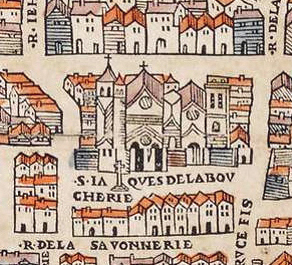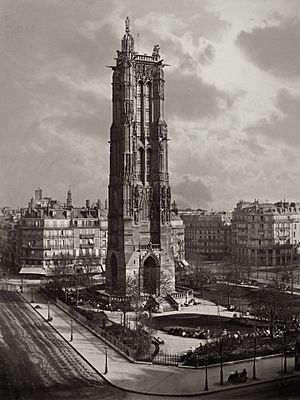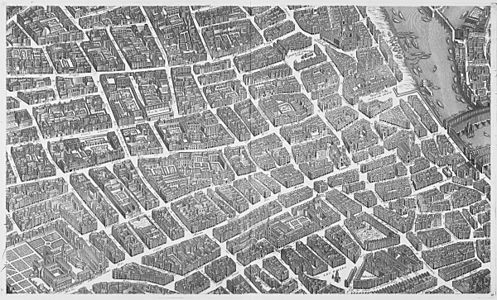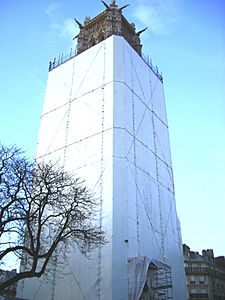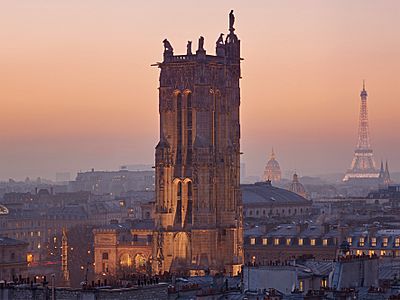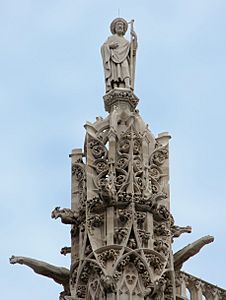Tour Saint-Jacques facts for kids
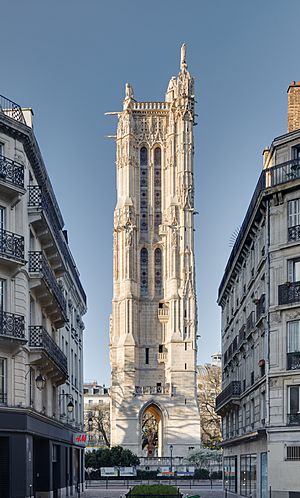
Tour Saint-Jacques in April 2015
|
|
| Coordinates | 48°51′28.7″N 2°20′56.1″E / 48.857972°N 2.348917°E |
|---|---|
| Location | 4th arrondissement of Paris |
| Type | Church ruins |
| Height | 52 metres (171 ft) |
| Beginning date | 1509 |
| Completion date | 1523 |
| Dedicated to | St James the Great |
| Criteria: | Cultural: ii, iv, vi |
| Designated: | 1998 (22nd session) |
| Part of: | Routes of Santiago de Compostela in France |
| Reference #: | 868-031 |
| Region: | Europe and North America |
|
Monument historique
|
|
| Designated: | 1862 |
| Reference #: | PA00086479 |
The Tour Saint-Jacques (which means 'Saint James's Tower' in French) is a famous monument in Paris, France. It stands 52 meters (about 170 feet) tall. This beautiful tower is all that is left of a large church from the 1500s. The church was called Saint-Jacques-de-la-Boucherie, meaning 'Saint James of the Meat Market'.
The church was torn down in 1797 during the French Revolution. Luckily, the tower was saved. Today, it is a national historic landmark. It is a great example of Flamboyant Gothic style, which means it has very fancy and flame-like decorations.
Contents
History of the Tower
A Stop on the Way of St James
The Tour Saint-Jacques was built between 1509 and 1523. Wealthy butchers from a nearby market helped pay for it. This shows how important and rich the area was back then. The tower was dedicated to Saint James the Greater.
The church and its tower were very important for pilgrims. These were people traveling on a long journey called the Way of St James. This path led to a major pilgrimage site in Spain, Santiago de Compostela. The church held a special relic (a holy item) of Saint James. Because of its link to this famous pilgrimage, the tower became a World Heritage Site in 1998. This means it is recognized as very important to the world's history and culture by UNESCO.
The Tower in the 1800s
After the church was destroyed in 1793, only the tower remained. For a while, it was even used to make small metal balls called "shot." This was done by dropping melted metal from the top.
In 1836, the City of Paris bought the tower. It was officially declared a historic monument in 1862. Later, a statue of Saint James was placed at the top.
During the mid-1800s, a famous architect named Théodore Ballu restored the tower. He also created a small park around it. This happened when new streets, like the Rue de Rivoli, were being built. The ground level around the tower was changed a lot. The tower was placed on a special base to keep its original height.
At the base of the tower, there is a statue of Blaise Pascal. He was a famous scientist. The statue remembers his experiments on air pressure. A weather lab is also located at the top of the tower today. The tower even inspired a play by the writer Alexandre Dumas.
A person named Nicolas Flamel, who was thought to be an alchemist, was buried under the church floor.
Modern Restoration Work
For several years, the Tour Saint-Jacques was covered in scaffolding. This was so experts could study the stone and fix any damage. They found that most of the tower's stone and decorations were original from the 1500s. However, they also found some serious cracks.
The top parts of the tower were uncovered in 2008, showing the newly repaired sections. By early 2009, all the scaffolding was removed. The park around the tower was also fixed up. Finally, on April 18, 2009, the park was opened again for everyone to enjoy.
Gallery
See also
 In Spanish: Torre de Santiago (París) para niños
In Spanish: Torre de Santiago (París) para niños
- Fontaine du Palmier
- Place du Châtelet


